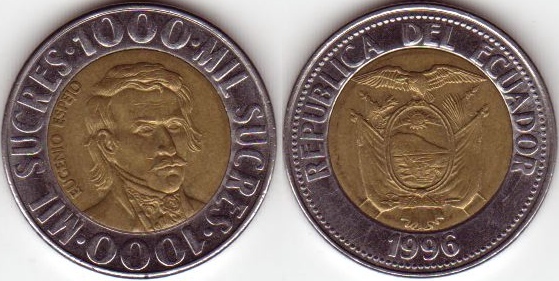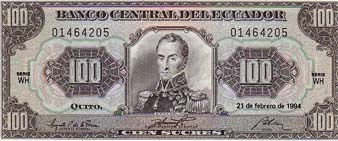|


The sucre was the currency of Ecuador between 1884 and 2000. Its ISO code was ECS and it was subdivided into 10 decimos or 100 centavos. The sucre was named after Antonio Jose de Sucre.
History
The Ecuadorian peso was renamed the sucre on March 22, 1884, and firmly placed on the silver standard. The sucre was defined as 22.5 g fine silver (equivalent to 5 francs of the Latin Monetary Union). Substandard coins were withdrawn between 1887 and 1892, only high-quality silver remaining in circulation.
The fall in the international price of silver accelerated in the 1890s, and on November 3, 1898 Ecuador switched to the gold standard, with the sucre defined as 732.224 mg fine gold (equivalent to 2 shillings sterling).
Like so many other currencies, the sucre became inconvertible shortly after World War I began in 1914. The exchange rate kept falling, despite extensive measures to support it. It was finally stabilized during 1926, and on March 4, 1927 Ecuador went on the gold exchange standard, with the sucre equal to 300.933 mg fine gold or US$0.20 (a devaluation of 58.8%).
The gold exchange standard was suspended February 8, 1932. Exchange controls were adopted April 30 and the official rate was fixed at 5.95 (buying) per U.S. dollar. After the price of silver rose above the nominal value of most silver coins in the 1930s, Ecuador embargoed the export of silver (May 17, 1935). This was followed by numerous adjustments to the foreign exchange system as the sucre continued to depreciate. Foreign exchange controls were finally lifted in September 1937 and the official rate was set at 13.5 sucre per U.S. dollar. The sucre was devalued to 14.77 sucre per dollar on June 4, 1940 and exchange controls were reimposed. The official rate became 14 in 1942 and 13.5 in 1944.
Parity was registered with the International Monetary Fund on December 18, 1946 at 65.827 mg fine gold (13.5 per US$), but a system of multiple exchange rates was adopted in 1947. The sucre's IMF par was devalued to 15 sucre per dollar in 1950, to 18 in 1961, and to 25 in 1970.
The sucre maintained a fairly stable exchange rate against the U.S. dollar until 1983, when it was devalued to 42 per dollar and a crawling peg was adopted. Depreciation gained momentum and the free market rate was over 800 per dollar by 1990 and almost 3000 in 1995.
The sucre lost 67% of its foreign exchange value during 1999, then in one week nosedived 17%, ending at 25,000 sucre = 1 U.S. dollar on January 7, 2000. On January 9, President Jamil Mahuad announced that the US dollar would be adopted as Ecuador's official currency. The US dollar became legal tender in Ecuador March 13, 2000 and sucre notes ceased being legal tender on September 11. Sucre notes remained exchangeable at Banco Central until March 30, 2001 at 25,000 sucres per dollar.
Coins
In 1884, cupro-nickel ½ and 1 centavo, and ½ decimo, and silver 1 and 2 decimos, ½ and 1 sucre coins were introduced. Centavo coins minted as subdivisions of the peso continued to circulate after the introduction of the sucre. Copper replaced cupronickel in the ½ and 1 centavo in 1890, whilst silver ½ decimo coins were introduced in 1893. The 10-centavo coin was called a real, with the 5-centavo coin known as a medio (meaning half). Gold 10 sucres were issued in 1899 and 1900.
In 1909, cupro-nickel ½, 1, 2 and 5 centavo coins were issued, followed by 2½ centavos in 1917 and 10 centavos in 1918. Production of silver coins was suspended in 1916. In 1928, a new coinage was introduced consisting of a bronze 1 centavo, nickel 2½, 5 and 10 centavos, silver 50 centavos, 1 and 2 sucres, and gold 1 condor. The 1 sucre coin was reduced from 25 grams of 90% silver to 5 grams of 72% silver, whilst the condor, worth 25 sucres, was equivalent to a U.S. quarter eagle coin. The new coins were dubbed Ayoras after the president, Isidro Ayora. In 1937, nickel 20 centavo and 1 sucre coins were introduced, followed by brass 5, 10 and 20 centavos in 1942 and silver 5 sucres in 1943. The last silver coins (2 and 5 sucres) were struck in 1944.
Cupro-nickel replaced brass in the 5, 10 and 20 centavos in 1946, with a cupro-nickel 1 sucre introduced in 1959. 1959 also saw the introduction of nickel-clad steel 20 centavos, with this metal replacing others in the 5, 10 and 50 centavos and 1 sucre between 1963 and 1970.
In 1988, nickel-clad steel coins for 10, 20 and 50 sucres were introduced, whilst high inflation in the 1990s lead to bi-metallic coins for 100, 500 and 1000 sucres being introduced between 1995 and 1996.
Banknotes
The first sucre-denominated banknotes were issued by private banks. The Banco del Ecuador issued provisional notes for 80 centavos and 4 sucres between 1885 and 1887 due to a conversion rate of 5 pesos = 4 sucres for the earlier notes of this bank. Regular notes were issued until 1926 in denominations of 1, 2, 5, 10, 20, 50, 100, 500 and 1000 sucres. 1 sucre notes were issued by the Banco Anglo-Ecuatoriano in 1885 and 1886, and by the Banco de Quito in 1885.
The Banco de la Union issued notes between 1887 and 1895 in denominations of 1, 5, 10, 20 and 100 sucres, whilst the Banco Internacional issued notes between 1887 and 1894 in denominations of 1, 5, 10, 20, 100, 500 and 1000 sucres. The Banco Comercial y Agricola issued notes between 1895 and 1925 in denominations of 1, 5, 10, 20, 50, 100, 500 and 1000 sucres. The Banco del Pinchincha issued notes for 1, 5, 10, 20, 50 and 10 sucres between 1907 and 1924. The Banco del Azuay issued 1, 2, 5 and 10 sucres notes between 1914 and 1924. The Campania de Credito Agricola e Industrial issued 2 and 10 sucres notes in 1921. Finally, the Banco de Decuento issued 5 and 50 sucres notes in 1923 and 1924.
In 1926, the Caja Central de Emision y Amortizacion was established to effect the transition of currency issues from private banks to a central bank. It issued notes in 1926 and 1927 in denominations of 1, 2, 5, 10 and 1000 sucres which were overprints on the notes of private banks.
The first notes of the Central Bank (Banco Central del Ecuador Sociedad Anonima) were issued in 1928 in denominations of 5, 10, 20, 50 and 100 sucres. These notes had a gold redemption clause, e.g.,PagarÃÆá al portador ÃÆá la vista CINCO SUCRES en oro o giros oro (promises to pay the bearer at sight FIVE SUCRES in gold or gold exchange). The gold clause was retained on Banco Central's notes until 1939, when the text was modified to PagarÃÆá al portador ÃÆá la vista CINCO SUCRES. Additional denominations of 500 and 1000 sucres were authorized in 1944.
In 1949-1950 Banco Central introduced new notes of reduced size (157 ÃÆÃâ 68 mm) in denominations of 5, 10, 20, 50 and 100 sucres, and dropped the phrase PagarÃÆá al portador ÃÆá la vista (will pay to the bearer at sight), leaving only the literal counter (i.e., the denomination). All banknotes circulated since 1928 had been printed by the American Bank Note Company, but Waterlow and Sons were now given the contract for the 5 and 50 sucre notes, which were the first Ecuadorian notes to have a security thread. In the late 1950s Waterlow was dropped in favour of Thomas de La Rue, which printed 5, 20, 50 and 100 sucre notes, while American Bank Note continued printing 5, 10, 20 and 100 sucre notes. Notes of both printers shared the same basic design, but while American Bank Note used collared planchets as a security device, de La Rue used a metal thread. These notes went through several modifications, and inflorescent security ink was introduced about 1970. A small-size 1000-sucre note was finally put into circulation in 1973.
The next change came in 1975, when the back of all circulating notes was redesigned to show the new national coat of arms. A small-size 500 sucre note appeared at the end of the 70s.
Beginning in 1984, the title Banco Central del Ecuador appears on the notes, without Sociedad Anonima. And a printer's imprint no longer appears on the notes. As inflation gained momentum, higher denominations were introduced: 5000 in 1987, 10,000 in 1988, 20,000 in 1995 and 50,000 in 1996.
Historic exchange rates
|
